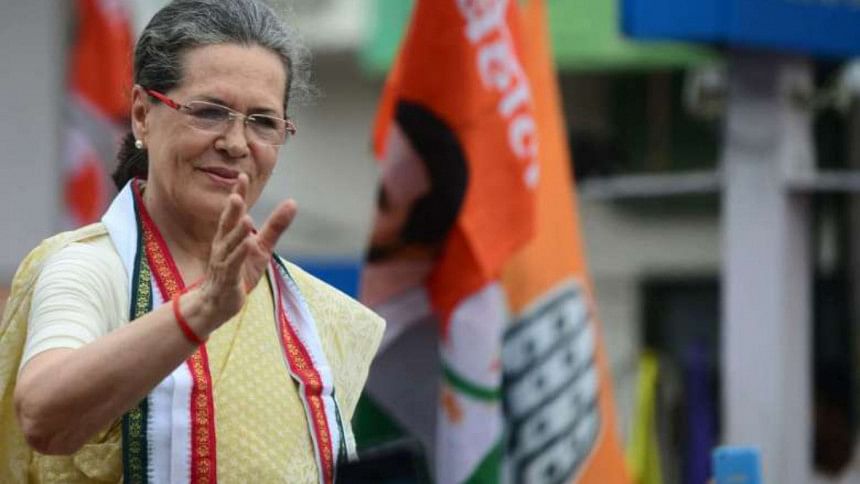Sonia Gandhi’s deja vu moment

It could be a déjà vu moment for Sonia Gandhi. Just a couple of months after returning to helm of the Congress, at a time of its existential crisis following the drubbing in April-May national elections, she faces a crucial test of her leadership in the October 21 assembly polls in Maharashtra and Haryana against a surging Bharatiya Janata Party.
Taking over the mantle as Congress President from her son Rahul Gandhi who quit owning responsibility for the rout in the Lok Sabha battle, Sonia finds herself in the same predicament as she did more than two decades ago when she became the party head for the first time—intense factionalism in the organisation closely followed by defeat in parliamentary elections. Today, the Congress is in a direr strait as added to the internecine war and national poll loss is the defection in party rank and file and a sense of disarray which, taken together, have made the party's task that much more difficult in the coming polls in Maharashtra and Haryana—both ruled by the BJP since 2014.
The Congress is still reeling under the after-effects of the parliamentary election debacles including in Maharashtra and Haryana. For three months after Rahul's resignation as party chief, the Congress was bogged down by leadership struggle failing to find someone outside the Gandhi clan to replace him and then settling for Sonia as "interim" President and its possible messiah. As the Congress spent weeks to find a replacement for Rahul as its chief, the BJP, seeking to cash in on the momentum of national poll victory, got down to the task of preparing for the Haryana and Maharashtra state polls.
There is recognition in the Congress that the challenge before the party in Maharashtra and Haryana state polls is Himalayan as it is confronted with the relentless election machinery of the BJP, and Prime Minister Narendra Modi government's withdrawal of special constitutional status of Jammu and Kashmir and its bifurcation which appears to have gained country-wide traction. In fact, in Harayana, the Congress chief ministerial face Bhupinder Singh Hooda has backed the Modi government's move on Kashmir.
In Maharashtra, electorally the most important state after Uttar Pradesh (Uttar Pradesh has 80 Lok Sabha seats and Maharashtra 48), a major headache for the Congress and its ally Nationalist Congress Party led by veteran Sharad Pawar in the forthcoming assembly elections, is that both have been hit by defection of a number of their important leaders in the last two months. Almost all their defected leaders joined the BJP. The NCP was hit harder by the switch of loyalty by its leaders as this has dealt a blow to its traditional clout in sugar belt and cooperative banking sectors in some regions of the state. Unlike the last assembly polls five years ago, the Congress and the NCP are fighting the coming battle in Maharashtra in partnership deciding to contest 125 seats of the 288-member state legislature.
If the results of this year's Lok Sabha elections are anything to go by, prospects of the Congress and the NCP in Maharashtra assembly poll look bleak as their combined vote-share was about 37 percent as against approximately 47 percent of the BJP and its oldest saffron ally Shiv Sena. Like the Congress and the NCP, the BJP and Shiv Sena are also fighting the coming assembly polls in alliance for the first time. When the two saffron parties had contested the previous assembly elections separately in 2014, the BJP emerged as the single largest party with 122 seats and the Sena a distant second with 63 only to form a post-poll coalition government.
In Haryana which has a 90-member legislature, the Congress's key challenge is to make its state unit click as a united team. Sonia Gandhi has managed to work out a truce in the unit recently by anointing Hooda as the party's campaign face and Kumari Selja as the state unit President in place of Ashok Tanwar and Kiran Chaudhuary. Both Tanwar and Chaudhary are sulking and this could exacerbate feud within the Congress in the state. The Congress may need to devote more time in keeping the two rival factions under leash till the elections than challenging the BJP on local developmental issues as well as the national issues of economic slowdown and joblessness.
Another worry for the Congress is that Bhupinder Singh Hooda faces a slew of corruption cases relating to land allotment and acquisition. Charge sheets have been filed in two of the five cases while probe is on into the others. The other major concern for the Congress is that by projecting Hooda as its campaign face, the party may have polarised the state's political scenario into a battle between its dominant Jat community and the non-Jat. The Congress has its task cut out as the BJP swept all the ten Lok Sabha seats in Haryana just four months ago.
A big question for the Congress in Maharashtra and Haryana is whether Rahul Gandhi will join the party's campaign there. Ever since the parliamentary poll defeat, Rahul is reportedly keeping a low profile in the party's activities, particularly when it comes to organisational matters. That may put extra pressure on Sonia as party President even though she has largely been off the election campaign trail since April 2017 due to indifferent health. Will she hit the ground running in Maharashtra and Haryana this time?
It took Sonia Gandhi six years to lead the Congress to victory in national elections in 2004 after becoming the party chief and then again in 2009 when Atal Bihari Vajpayee was the BJP's Prime Ministerial face. In 2014 Lok Sabha poll, Sonia-led Congress suffered its worst electoral defeat against a Modi-charged BJP. Rahul was hardly any different for the Congress in 2019. Now that Sonia is back in the saddle, can she change the party's fortunes in Maharashtra and Haryana? There are no two opinions that Modi is different from Vajpayee when it comes to aggressively and resolutely pushing the party's march forward without brooking any resistance.
Pallab Bhattacharya is a special correspondent for The Daily Star.

 For all latest news, follow The Daily Star's Google News channel.
For all latest news, follow The Daily Star's Google News channel. 



Comments